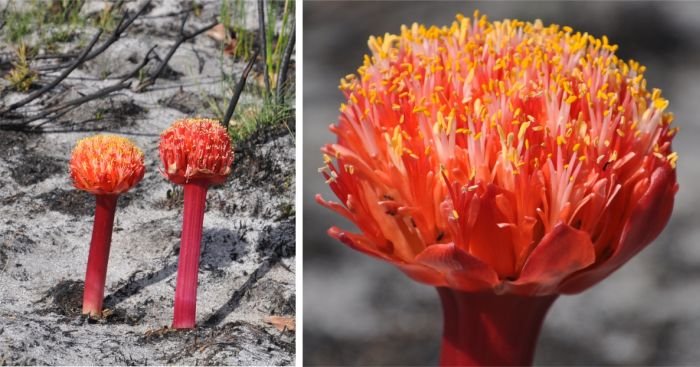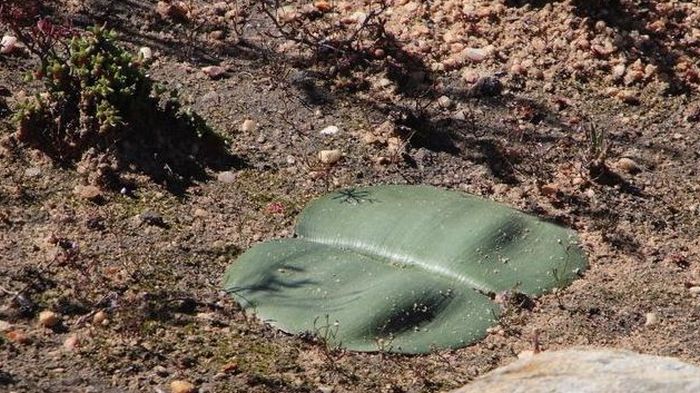Haemanthus sanguineus
Haemanthus sanguineus Jacq.
Family: Amaryllidaceae
Common names: smooth bloodlily, April fool (Eng.); veldskoenblaar, brandlelie (Afr.)
Introduction
The blood-red flowers of Haemanthus sanguineus stand out in the late summer flowering season, and its magnificent leaves are quite spectacular to see during the winter growing season, and they give texture to a landscaped area.

Description
Description
Haemanthus sanguineus is a winter-growing, deciduous bulb and reaches a height of 300 mm when flowering. This species has an egg-shaped bulb, 40–100 mm in diameter, that is covered in thinly layered, white to yellow scales. Each bulb produces 2 leathery green leaves, 80–400 mm long, often with red, cartilaginous margins. The leaves are circular to broadly oblong and usually lie flat on the ground, just above the surface of the soil.

Haemanthus sanguineus has a rounded, pink to red inflorescence on a plain red peduncle, which protrudes before the leaves emerge. This inflorescence appears in late summer to autumn (from January to April) and consists of many flowers crowded into a dense head, surrounded by leathery floral bracts. The stamens are well exserted and carry yellow pollen. Fleshy pink or red berries follow the flowers, holding a few reddish-brown, egg-shaped seeds.
Haemanthus sanguineus is often mistaken for H. coccineus, but the latter species does not have a leathery leaf margin and it has a spotted peduncle. Also, the floral bracts of H. sanguineus are smaller so that the flowers stick out above them, whereas those of H. coccineus are larger and cover the flowers.
Conservation Status
Status
According to the Red List of South African plants website, this species is not threatened and has a conservation status of Least Concern (LC).

Distribution and habitat
Distribution description
Haemanthus sanguineus occurs mainly in the southwestern parts of the Western Cape to the southern Eastern Cape, from Clanwilliam to Gqeberha (formerly Port Elizabeth). This species often grows in rocky outcrops, prefers well-drained sandy and loam soils, but can also tolerate clay soils. It grows in full sun, often in the shade of shrubs and is mainly found in Waboomveld, Succulent Karoo, Fynbos and Renosterveld veld types.

Derivation of name and historical aspects
History
Haemanthus sanguineus belongs to the Amaryllidaceae, of which 22 species occur in the Klein Karoo.
The name of the genus Haemanthus, is derived from the Greek words, haima, meaning ‘blood’ and anthos, meaning ‘flower’, which refers to the colour of the perianth and floral bracts of many of the species in the genus. The species name sanguineus, means ‘blood-red’ and refers to the colour of the flower heads.
According to Duncan, Jeppe & Voigt (2016), N.J. Jacquin described and illustrated this species in 1804 in volume 4 of Plantarum rariorum horti caesarei Schoenbrunnensis. A decade later, English botanist J.B. Ker Gawler published the same species as H. rotundifolius in Curtis’s Botanical Magazine, illustrated by Sydenham Edwards, who depicted a better specimen, showing the typically prostrate, rotund leaves with red, leathery margins and red, ovate spathe bracts. This species became widely known under the latter name until it was placed in synonymy under H. sanguineus by D. Snijman in 1984, in A revision of the genus Haemanthus.

Ecology
Ecology
Haemanthus sanguineus flowers attract many insects and sunbirds, which are the main pollinators. The Mountain Pride butterfly (Aeropetes tulbaghia) has also been seen feeding on the flowers. Seeds develop in a couple of weeks after flowering and are very fleshy, covered by a thin skin. Many seeds drop close to the mother plant. Tortoises have been seen eating the red berries and, because they don’t digest the seeds, they excrete them in their droppings, which leads to their dispersal and germination. Seeds have a short period of viability, and germinate immediately.

Haemanthus sanguineus plants are adapted to a winter-rainfall climate, and can withstand long periods of drought. They store food reserves in their large bulbs, enabling them to survive during the dormant summer season. New leaves emerge in autumn, are green and growing during the rainy winter, and die back in spring to early summer, when the plant enters dormancy.

Haemanthus sanguineus flowers prolifically after a fire burns through the vegetation, and the inflorescences are frequently seen emerging a few weeks after fires.
Uses
Use
Haemanthus sanguineus makes an excellent ornamental plant in rockeries and water-wise gardens, bringing colour during the late summer season. This species is not known for any medicinal or cultural uses, but its close relative, Haemanthus coccineus is known for treating bruises, sores, sprains and asthma.

Growing Haemanthus sanguineus
Grow
Haemanthus sanguineus grows very easily from seed. Sow seed as soon as it is ripe, in a sowing medium of equal quantities of coarse river sand and well-decomposed, sieved compost. Seeds should be sowed thinly and kept moist and not wet.
This species makes excellent, water-wise plants that can be used in rockeries or display areas during the flower season and they can be grown in large containers. These bulbs tend to flower erratically without intervention. Burning a layer of dead twigs and leaves on the bulbs in late summer should encourage flowering. Adult plants can be watered once a week during the season of active growth. Place plants in full sun with high light intensity for optimum flowering. Watering of H. sanguineus should stop during the summer season when the plants go into dormancy. Ignoring the latter could lead to the plant rotting or not flowering during the flowering season.
The Amaryllis caterpillar and snails are famous for attacking the leaves and peduncle of the flower. These caterpillars and snails can easily be removed by hand.
References
- Clarke, H. & Charters, M. 2016. The illustrated dictionary of southern African plant names. Flora & Fauna Publications Trust, Jacana, Johannesburg.
- Du Plessis, N. & Duncan, G. 1989. Bulbous plants of southern Africa, a guide to their cultivation and propagation. Tafelberg, Cape Town.
- Duncan, G. 2010. Grow bulbs. A guide to the cultivation of bulbs of South Africa and neighboring countries. Kirstenbosch Gardening Series. South African National Biodiversity Institute, Cape Town.
- Duncan, G., Jeppe, B. & Voigt, L. 2016. The Amaryllidaceae of southern Africa. Umdaus Press, Pretoria.
- Snijman, D.A. & Victor, J.E. 2004. Haemanthus sanguineus Jacq. National Assessment: Red List of South African Plants version 2020.1. Accessed on 2021/07/29
- Vlok, J. & Schutte-Vlok, A.L. 2010. Plants of the Klein Karoo. Umdaus Press, Hatfield.
Credits
Ricardo Riddles
Karoo Desert National Botanical Garden
September 2021
Acknowledgements: the author thanks Tony Rebelo, Ismail Ebrahim and Alice Notten for the amazing pictures that illustrate this article.
Plant Attributes:
Plant Type: Bulb
SA Distribution: Eastern Cape, Western Cape
Soil type: Sandy, Clay, Loam
Flowering season: Late Summer, Autumn
PH: Acid
Flower colour: Red, Pink
Aspect: Full Sun
Gardening skill:
Special Features:
Horticultural zones








Rate this article
Article well written and informative
Rate this plant
Is this an interesting plant?
Login to add your Comment
Back to topNot registered yet? Click here to register.